2020 TOYOTA PRIUS PRIME battery capacity
[x] Cancel search: battery capacityPage 91 of 792

PRIUS PRIME_OM_OM47C77U_(U)
912-1. Plug-in hybrid system
2
Plug-in hybrid system
■Switching to the hybrid battery (traction battery) charge mode
Press and hold the switch.
Take your hand off the switch
once the hybrid battery charge
mode indicator starts to blink.
The hybrid battery charge mode
indicator illuminates when the
switch to hybrid battery (traction
battery) charge mode is com-
plete.
When the hybrid battery (traction battery) is fully charged
*, the hybrid
battery (traction battery) charge mode is automatically cancele d and the
operation mode will be switched to HV mode.
The hybrid battery (traction battery) charge mode will be cance led by
pressing EV/HV mode selection switch or EV auto mode switch.
*: The maximum charge amount in the hybrid battery (traction batt ery)
charge mode is approximately 80% of the fully charged capacity for the
charging from an external power source.
■ If the plug-in hybrid system ope ration mode cannot be changed
In the following situations, the plug-in hybrid system operation mode cannot
be changed even if the EV/HV mode selection switch or EV auto mode switch
is pressed. (In this case, the warning message is displayed on the multi-infor-
mation display when the switch is pressed.)
● When electricity needed for EV driving is not remaining (when in EV/EV
auto mode)
● When the traction battery is almost completely charged (hybrid battery [trac-
tion battery] charge mode)
■ When switching from EV mode to another mode using the switch
When the power switch is turned of f, operation mode switching is canceled
and the system returns to EV mode the next time the vehicle is started.
■ Hybrid battery (traction battery) charge mode
●The following may occur to protect the system, etc.
• Cannot switch to hybrid battery (traction battery) charge mode or cannot
cancel it
• Gasoline engine does not start or stops even after switching to hybrid bat- tery (traction battery) charge mode
● If a load to the system is large, such as when the power consumption of the
air conditioning system is large or when the temperature of the engine cool-
ant is high, it may take longer time than usual to charge using the hybrid bat-
tery (traction battery) charge mode, or charging to the hybrid battery
(traction battery) may not be performed.
Page 100 of 792
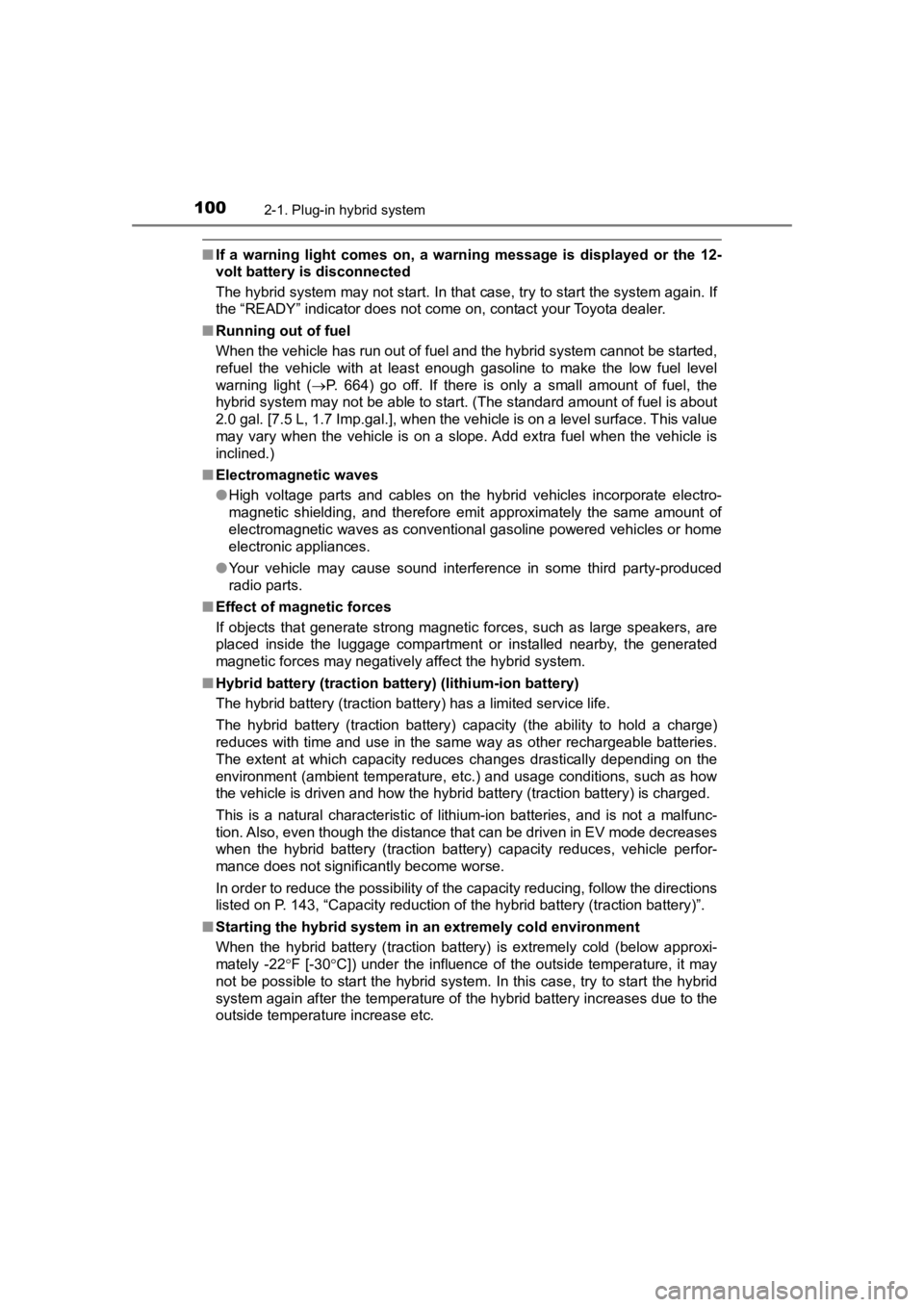
100
PRIUS PRIME_OM_OM47C77U_(U)
2-1. Plug-in hybrid system
■If a warning light comes on, a warning message is displayed or the 12-
volt battery is disconnected
The hybrid system may not start. In that case, try to start the system again. If
the “READY” indicator does not come on, contact your Toyota dea ler.
■ Running out of fuel
When the vehicle has run out of fuel and the hybrid system cann ot be started,
refuel the vehicle with at least enough gasoline to make the lo w fuel level
warning light ( P. 664) go off. If there is only a small amount of fuel, the
hybrid system may not be able to start. (The standard amount of fuel is about
2.0 gal. [7.5 L, 1.7 Imp.gal.], when the vehicle is on a level surface. This value
may vary when the vehicle is on a slope. Add extra fuel when th e vehicle is
inclined.)
■ Electromagnetic waves
●High voltage parts and cables on the hybrid vehicles incorporat e electro-
magnetic shielding, and therefore emit approximately the same amount of
electromagnetic waves as conventional gasoline powered vehicles or home
electronic appliances.
● Your vehicle may cause sound interference in some third party-p roduced
radio parts.
■ Effect of magnetic forces
If objects that generate strong magnetic forces, such as large speakers, are
placed inside the luggage compartment or installed nearby, the generated
magnetic forces may negatively affect the hybrid system.
■ Hybrid battery (traction batt ery) (lithium-ion battery)
The hybrid battery (traction battery) has a limited service lif e.
The hybrid battery (traction battery) capacity (the ability to hold a charge)
reduces with time and use in the same way as other rechargeable batteries.
The extent at which capacity reduces changes drastically depending on the
environment (ambient temperature, etc.) and usage conditions, such as how
the vehicle is driven and how the hybrid battery (traction batt ery) is charged.
This is a natural characteristic of lithium-ion batteries, and is not a malfunc-
tion. Also, even though the distance that can be driven in EV m ode decreases
when the hybrid battery (traction battery) capacity reduces, ve hicle perfor-
mance does not significantly become worse.
In order to reduce the possibility of the capacity reducing, fo llow the directions
listed on P. 143, “Capacity reduction of the hybrid battery (tr action battery)”.
■ Starting the hybrid system in a n extremely cold environment
When the hybrid battery (traction battery) is extremely cold (b elow approxi-
mately -22 F [-30C]) under the influence of the outside temperature, it may
not be possible to start the hybrid system. In this case, try to start the hybrid
system again after the temperature of the hybrid battery increases due to the
outside temperature increase etc.
Page 134 of 792
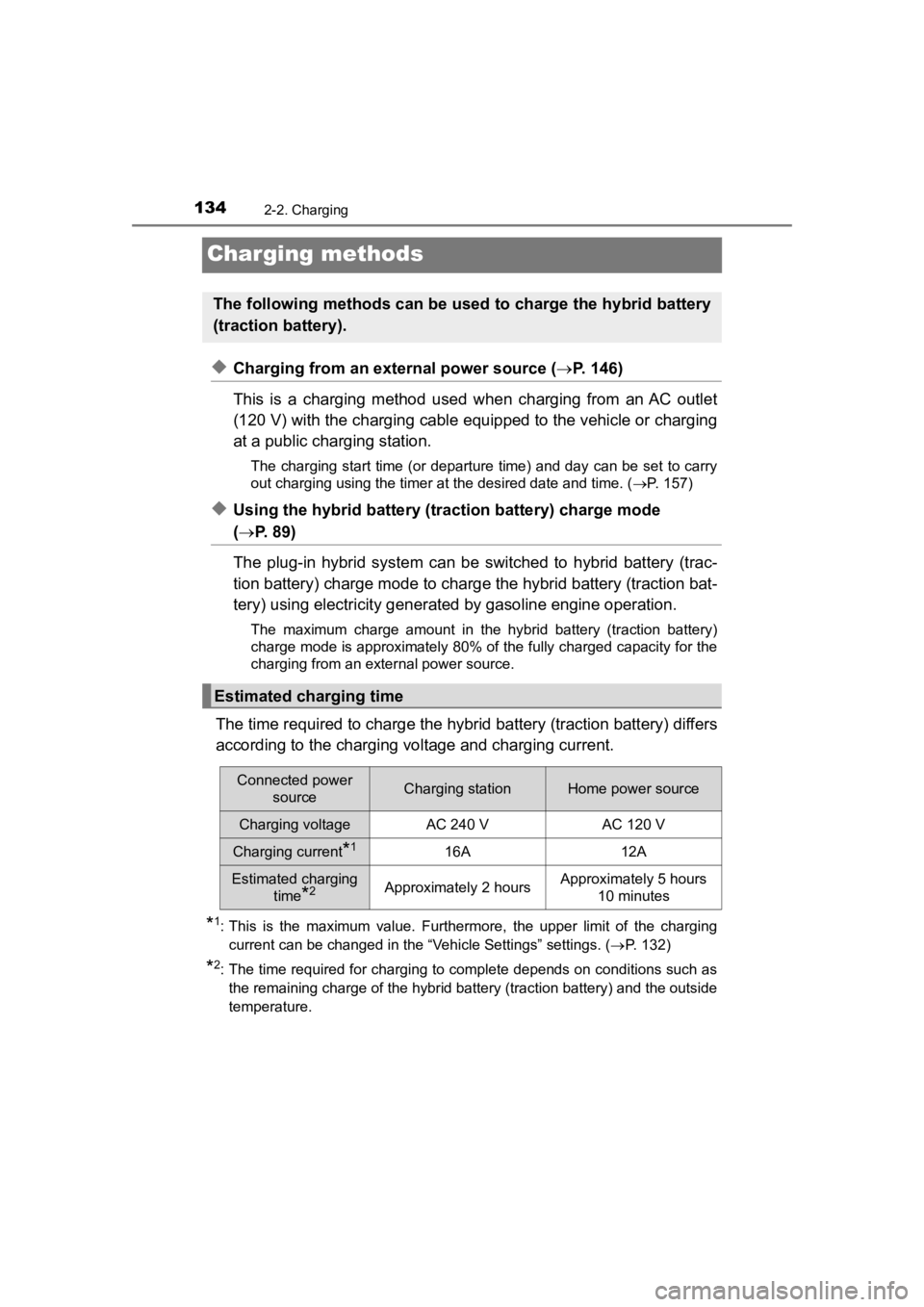
134
PRIUS PRIME_OM_OM47C77U_(U)
2-2. Charging
Charging methods
◆Charging from an external power source (P. 146)
This is a charging method used when charging from an AC outlet
(120 V) with the charging cable equipped to the vehicle or char ging
at a public charging station.
The charging start time (or departure time) and day can be set to carry
out charging using the timer at the desired date and time. ( P. 157)
◆Using the hybrid battery (traction battery) charge mode
( P. 89)
The plug-in hybrid system can be switched to hybrid battery (trac-
tion battery) charge mode to charge the hybrid battery (tractio n bat-
tery) using electric ity generated by gas oline engine operation.
The maximum charge amount in the hybrid battery (traction battery)
charge mode is approximately 80% of the fully charged capacity for the
charging from an external power source.
The time required to charge the hybrid battery (traction battery) differs
according to the charging vol tage and charging current.
*1: This is the maximum value. Furthermore, the upper limit of the charging
current can be changed in the “Vehicle Settings” settings. ( P. 1 3 2 )
*2: The time required for charging to complete depends on conditions such as
the remaining charge of the hybrid battery (traction battery) and the outside
temperature.
The following methods can be used to charge the hybrid battery
(traction battery).
Estimated charging time
Connected power sourceCharging stationHome power source
Charging voltageAC 240 VAC 120 V
Charging current*116A12A
Estimated charging
time
*2Approximately 2 hoursApproximately 5 hours 10 minutes
Page 143 of 792

PRIUS PRIME_OM_OM47C77U_(U)
1432-2. Charging
2
Plug-in hybrid system
■Capacity reduction of the hybr id battery (traction battery)
The capacity of the hybrid battery (traction battery) will decline gradually
when the hybrid battery (traction battery) is in use. The rate at which it
declines will differ in accordance with environmental condition s and the way
in which the vehicle is used. Observing the following can help suppress bat-
tery capacity decline.
● Avoid parking the vehicle in areas with a high temperature unde r direct sun-
light when the hybrid battery (traction battery) is fully charged.
● Avoid accelerating and decelerating frequently and suddenly when EV driv-
ing.
● Avoid frequent driving near the top speed for EV driving. ( P. 95)
● Leave a low level of charge in the hybrid battery (traction bat tery) when
leaving the vehicle undriven for a long period of time.
After confirming that EV mode has switched to HV mode, turn the power
switch off.
● Use the charging timer function as much as possible in order to fully
charge the hybrid battery (traction battery) immediately before starting
off. ( P. 157)
Also, if the hybrid battery (traction battery) capacity reduces , the distance that
can be driven in EV mode decreases. However, vehicle performanc e does
not significantly become worse.
■ When the remaining charge of the hybrid battery (traction battery) is low
after charging
In the following situations, the remaining charge of the hybrid battery (traction
battery) after charging completes may be less than normal in or der to protect
the system (the EV driving range after the battery is fully charged may be
shorter).
*
● Charging is carried out when the outside temperature is low or high
● Charging is carried out immediately after high-load driving or in extreme
heat
When none of the above situations apply and there is a drastic drop in the
remaining charge of the hybrid battery (traction battery) after charging com-
pletes, have the vehicle inspected by your Toyota dealer.
*: When this occurs, even if the remaining charge display of the hybrid battery
(traction battery) shows that it is fully charged, the remainin g charge rapidly
decreases faster than normal.
■ When the charging amount sent to the hybrid battery (traction battery)
decreases
When the amount of power supplied by the charging equipment is low or
operation of the “Traction Battery Heater”, etc., reduces the c harging power
sent to the hybrid battery (traction battery), the charging amo unt sent to the
hybrid battery (traction battery) may decrease.
Page 271 of 792
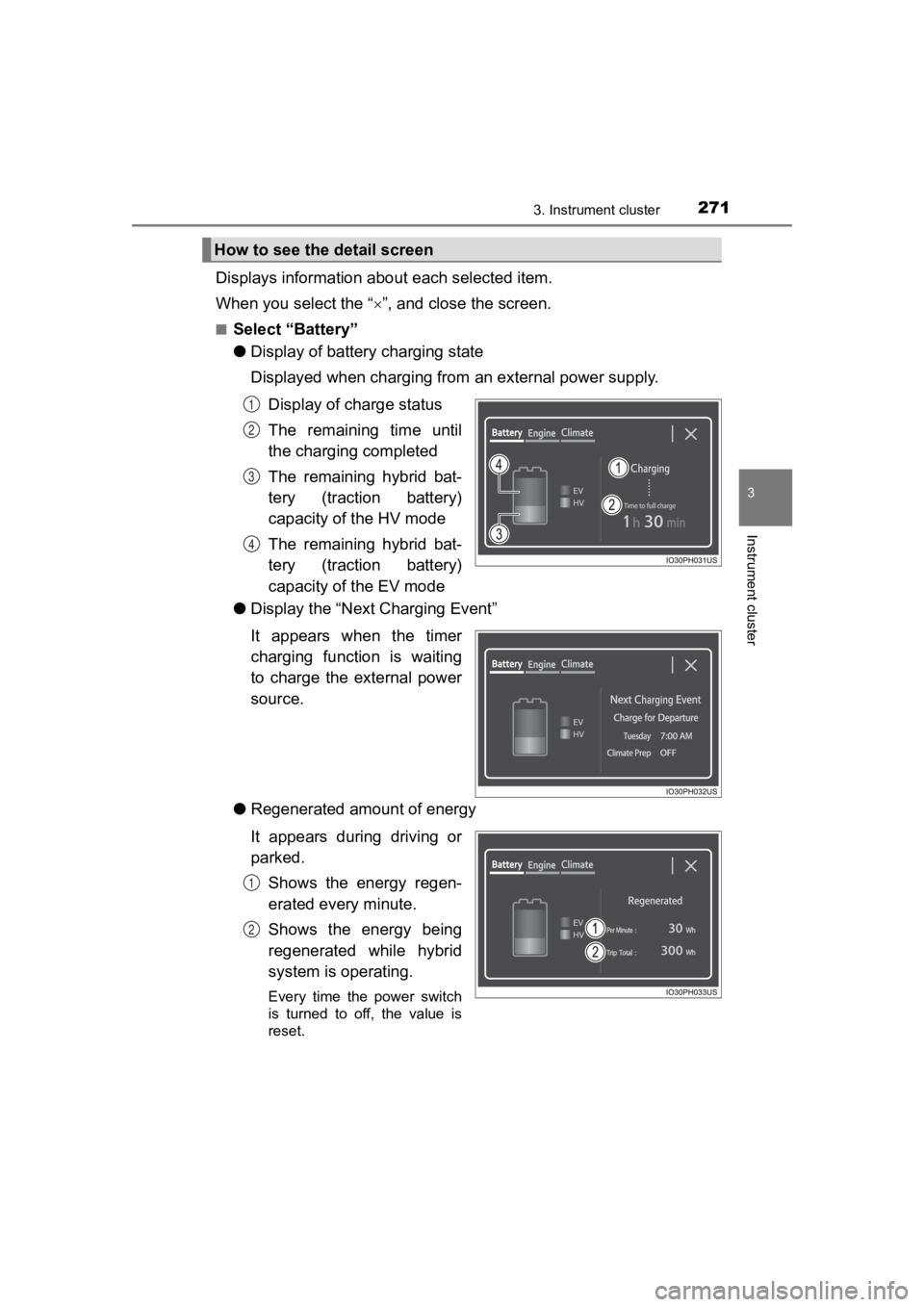
PRIUS PRIME_OM_OM47C77U_(U)
2713. Instrument cluster
3
Instrument cluster
Displays information about each selected item.
When you select the “ ”, and close the screen.
■Select “Battery”
●Display of battery charging state
Displayed when charging from an external power supply.
Display of charge status
The remaining time until
the charging completed
The remaining hybrid bat-
tery (traction battery)
capacity of the HV mode
The remaining hybrid bat-
tery (traction battery)
capacity of the EV mode
● Display the “Next Charging Event”
It appears when the timer
charging function is waiting
to charge the external power
source.
● Regenerated amount of energy
It appears during driving or
parked.
Shows the energy regen-
erated every minute.
Shows the energy being
regenerated while hybrid
system is operating.
Every time the power switch
is turned to off, the value is
reset.
How to see the detail screen
1
2
3
4
1
2
Page 706 of 792

7068-2. Steps to take in an emergency
PRIUS PRIME_OM_OM47C77U_(U)■
When recharging or replacing the 12-volt battery
●In some cases, it may not be possible to unlock the doors using the smart
key system when the 12-volt battery is discharged. Use the wire less remote
control or the mechanical key to lock or unlock the doors.
● The hybrid system may not start on the first attempt after the 12-volt battery
has recharged but will start normally after the second attempt. This is not a
malfunction.
● Vehicles with smart lid & connector locking system:
It may be impossible to unlock the charging port lid or locking and unlocking
the charging connector immediately after the 12-volt battery is reconnected.
In this case, carry the electronic key on your person and opera te the
charging port lid or charging connector lock switch again.
● The power switch mode is memorized by the vehicle. When the 12- volt bat-
tery is reconnected, the system will return to the mode it was in before the
12-volt battery was discharged. Before disconnecting the 12-volt battery,
turn the power switch off.
If you are unsure what mode the power switch was in before the 12-volt bat-
tery discharged, be especially careful when reconnecting the 12 -volt battery.
● If the 12-volt battery discharges while the shift position is in P, it may not be
possible to shift the shift position to other positions. In thi s case, the vehicle
cannot be towed without lifting both front wheels because the f ront wheels
will be locked. ( P. 655)
■ When replacing the 12-volt battery
●Use a 12-volt battery that conforms to European regulations.
● Use a 12-volt battery that the case size is same as the previou s one (LN1),
20 hour rate capacity (20HR) is equivalent (45Ah) or greater, and perfor-
mance rating (CCA) is equivalent (295A) or greater.
• If the sizes differ, the 12-volt battery cannot be properly se cured.
• If the 20 hour rate capacity is low, even if the time period w here the vehi-
cle is not used is a short time, the 12-volt battery may discharge and the
hybrid system may not be able to start.
● For details, consult your Toyota dealer.
Page 721 of 792
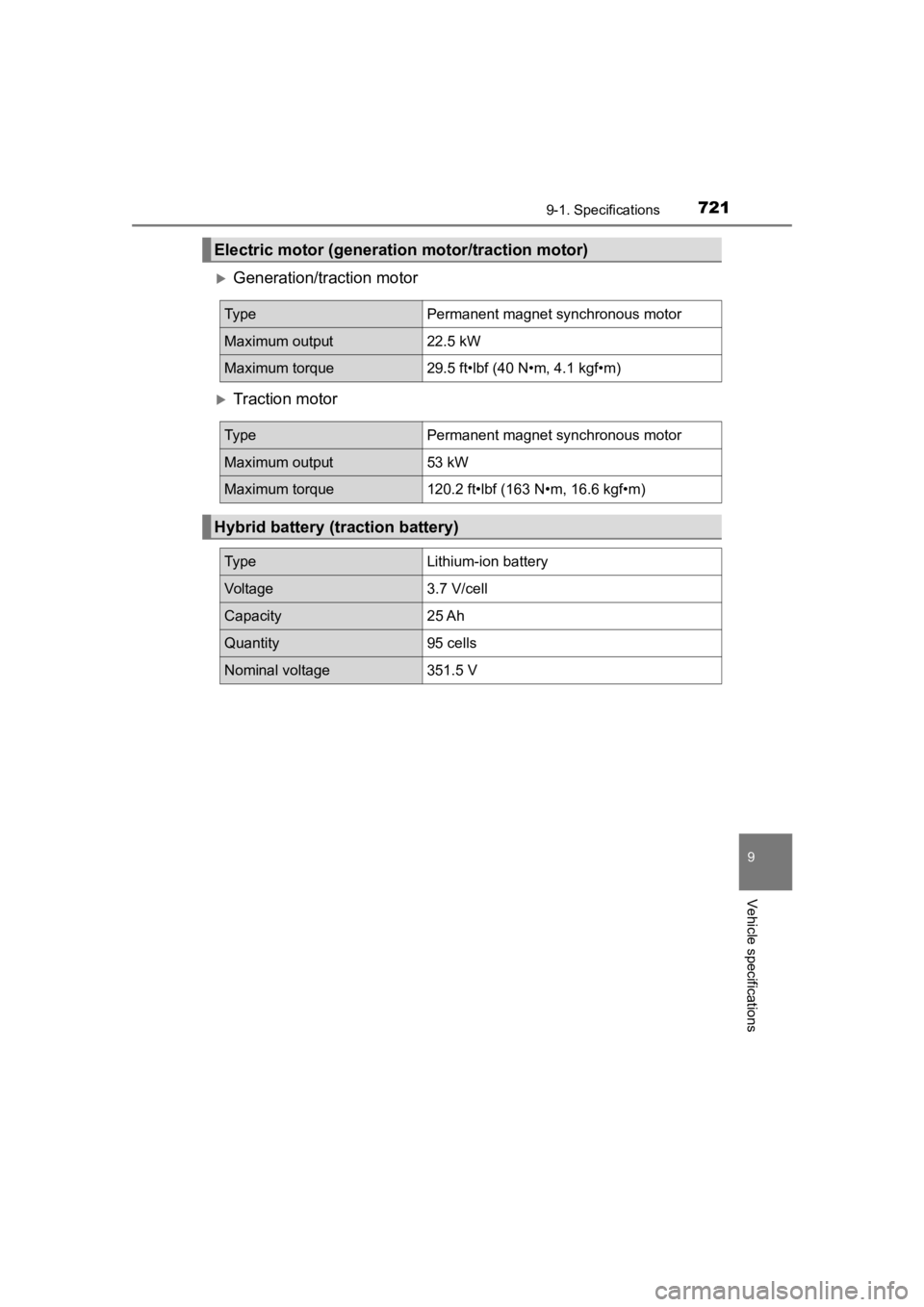
PRIUS PRIME_OM_OM47C77U_(U)
7219-1. Specifications
9
Vehicle specifications
Generation/traction motor
Traction motor
Electric motor (generation motor/traction motor)
Ty p ePermanent magnet synchronous motor
Maximum output22.5 kW
Maximum torque29.5 ft•lbf (40 N•m, 4.1 kgf•m)
Ty p ePermanent magnet synchronous motor
Maximum output53 kW
Maximum torque120.2 ft•lbf (163 N•m, 16.6 kgf•m)
Hybrid battery (traction battery)
Ty p eLithium-ion battery
Vol t a ge3.7 V/cell
Capacity25 Ah
Quantity95 cells
Nominal voltage351.5 V
Page 724 of 792
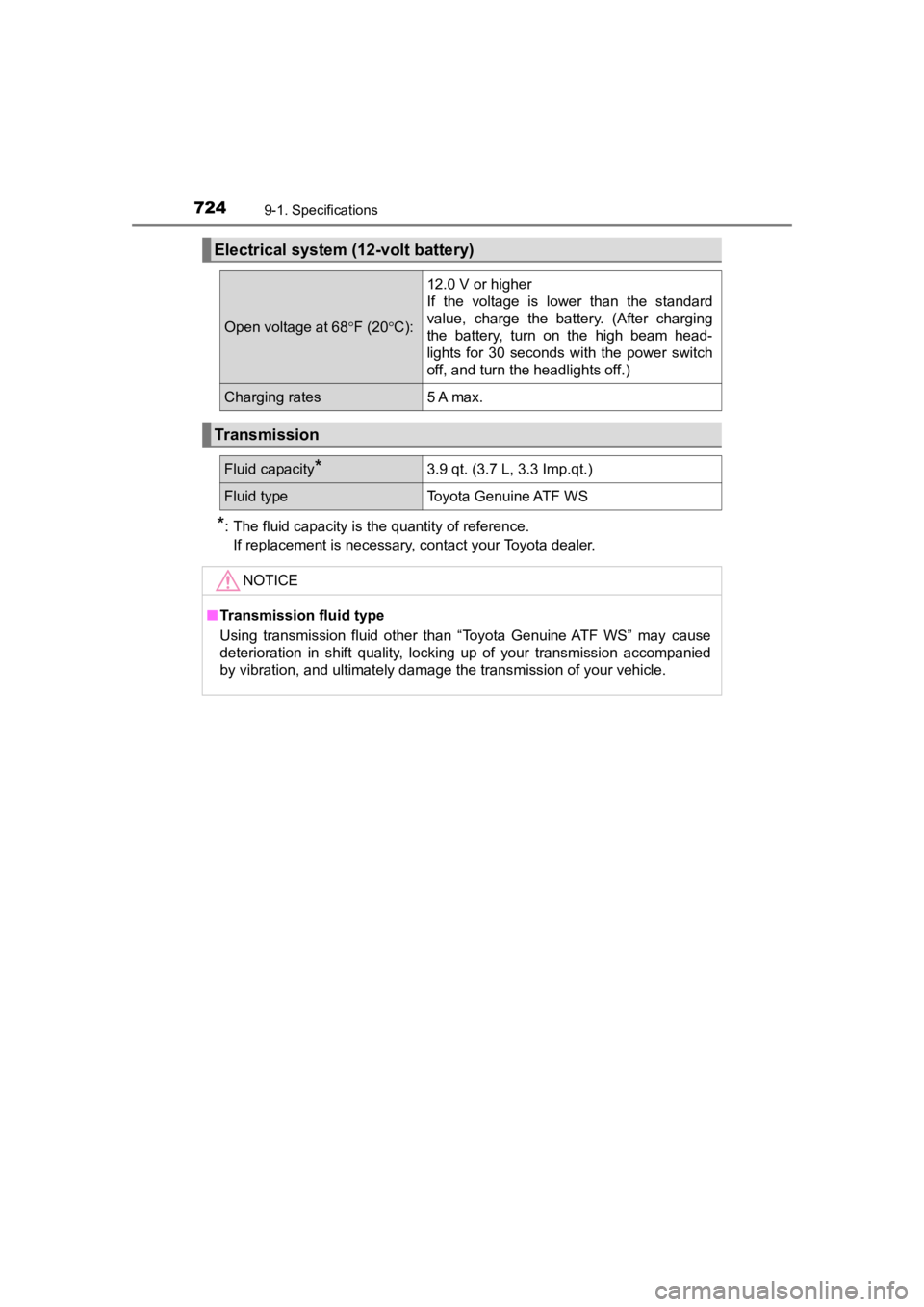
724
PRIUS PRIME_OM_OM47C77U_(U)
9-1. Specifications
*: The fluid capacity is the quantity of reference.If replacement is necessary, contact your Toyota dealer.
Electrical system (12-volt battery)
Open voltage at 68 F (20 C):
12.0 V or higher
If the voltage is lower than the standard
value, charge the battery. (After charging
the battery, turn on the high beam head-
lights for 30 seconds with the power switch
off, and turn the headlights off.)
Charging rates5 A max.
Transmission
Fluid capacity*3.9 qt. (3.7 L, 3.3 Imp.qt.)
Fluid typeToyota Genuine ATF WS
NOTICE
■ Transmission fluid type
Using transmission fluid other than “Toyota Genuine ATF WS” may cause
deterioration in shift quality, locking up of your transmission accompanied
by vibration, and ultimately damage the transmission of your ve hicle.